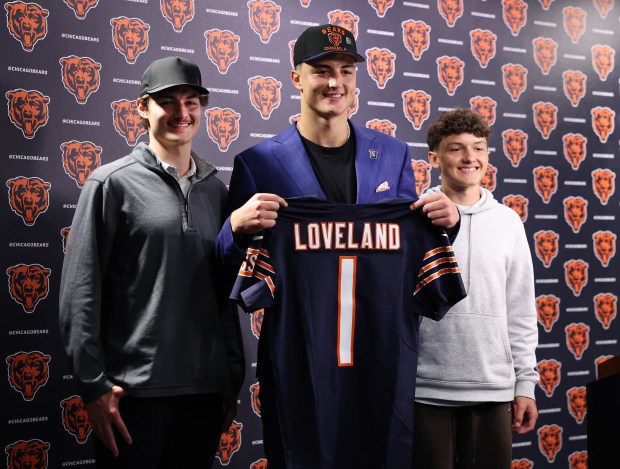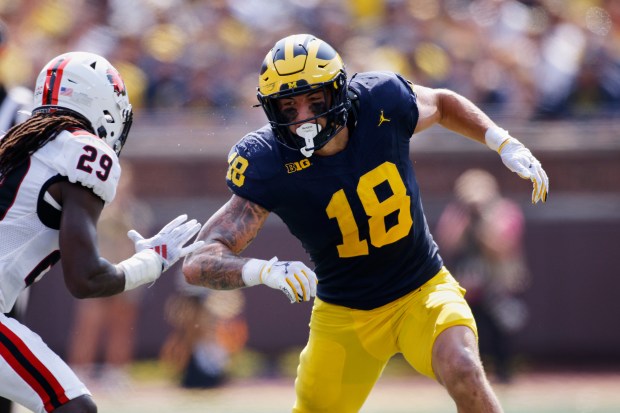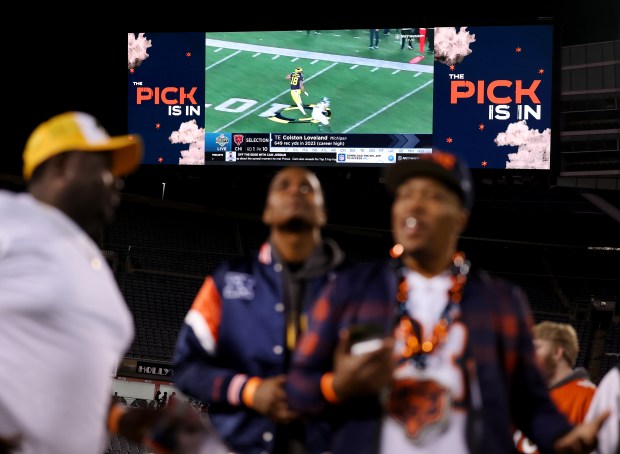The three Loveland brothers sat in a row on the couch at their aunt and uncle’s house in Gooding, Idaho. A crowd of friends and family sat behind them. Everyone zeroed in on the TV.
Overlooking it all from the back wall were two giant elk heads.
On the TV, NFL Commissioner Roger Goodell announced, “The Chicago Bears select Colston … ”
The room exploded. The cheers that came from the assembled crowd drowned out Colston Loveland’s last name. Loveland shared a hug with his older brother, Cayden, then turned to his younger brother, Cash, who already was handing him a Bears hat.
Only moments before, the tight end out of Michigan had been on the phone with Bears coach Ben Johnson. In an otherwise quiet draft room at Halas Hall, Johnson radiated nervous energy.
“Let’s go!” Johnson said on the phone. “What we got, man? Tell me something now.”
“Come on now!” Loveland said. “Come on now!”
“We cooking with hot grease now, man, I’m telling you!” Johnson said.
The coach couldn’t stop rocking in his chair, back and forth, back and forth. The Bears, with the No. 10 pick in the draft, found a new weapon for quarterback Caleb Williams. Loveland became the Bears’ highest-drafted tight end since Mike Ditka at No. 5 in 1961.
“It’s the first pick as a head coach, man,” Johnson told Loveland. “You’re exactly what we’re looking for.”
Johnson arrived in Chicago three months ago. He brought with him from the Lions a confidence that the Bears can build an offense like the one he built in Detroit. The Lions assembled a juggernaut behind quarterback Jared Goff, an offense that ranked among the league’s best in both passing and rushing over the last two seasons.
The tight end position was a huge part of that ascendancy. The Lions drafted Sam LaPorta out of Iowa with the No. 34 pick in 2023. LaPorta made an instant impact with 86 catches for 889 yards and 10 touchdowns as a rookie. The Lions used multiple tight ends as much as any team in the NFL.
When Johnson and Loveland had their first significant conversation at Loveland’s pro day in March, the coach asked Loveland which tight ends he likes to watch. Rob Gronkowski and Jimmy Graham are two of his all-time favorites. But he made sure to mention LaPorta too.
“You remind me a lot of him,” Johnson told LaPorta that day.
A month later, on draft night, Johnson couldn’t stop grinning as he spoke with Loveland on the phone.
“A match made in heaven,” Johnson said.
‘Mining for gold’

About those elk on the wall. Loveland’s aunt and uncle own a farm, and their house was big enough to host a crowd. And Loveland drew a crowd. He had 150 people with him and another 500 watching from a nearby country club.
Loveland is Idaho through and through. Bears general manager Ryan Poles called him “Idaho tough.” When Poles asked him about his hand strength, Loveland responded with a question of his own.
“Have you ever put up wire fence in Idaho?”
The GM has not.
It made perfect sense that Loveland would watch the draft back home. While others walked across the stage in Green Bay before the bright lights and the cameras, Loveland settled in on a couch with his people by his side and the elk watching over it all.
“Where I’m from, really Idaho as a whole, all everyone does there is work,” Loveland said. “Seeing how my parents grew up, they just worked their butts off. Everyone in the community, very blue collar. It’s just a different lifestyle up there.”
Loveland used to help his aunt and uncle brand calves at the farm each spring. He always liked those days because he got to skip school — but he made sure to be done in time to go to football practice. Loveland played football and basketball as a kid but he also competed in rodeo until fifth grade, though he downplayed those exploits.
“I was doing goat flanking, riding calves, steers,” Loveland said. “Nothing too crazy at all.”
It’s more than most first-round draft picks can say.
In fifth grade, Loveland’s rodeo career was at an inflection point. His mother, Rachel Faulkner, asked him: Was it time to buy horses, trailers, saddles? If he was going to do this, that’s what it was going to take.
Loveland decided he was better off focusing on football and basketball.
It was around that same time that then-Gooding High School football coach Cameron Andersen went to a sixth grade football game. The player who caught his eye, though, was a fifth grader who was forced to play on the offensive line because he was too big at that age to carry the football.
Gooding is a small community of about 3,800 people. Andersen knew the Loveland family. He had played against Colston’s dad, Chad Loveland, when they were growing up. He knew of Colston’s older brother, Cayden.
Andersen began to imagine the possibilities. He followed Colston over the next several years. The junior high team played its games on the varsity field while the varsity team practiced nearby. Andersen could keep a close eye on the athletes who would soon be entering his program.
“He was not fast at all, but everywhere the ball was, he was,” said Andersen, who now coaches at Burley High School in Idaho. “He just had a knack. When it got thrown up, if it was short, he caught it. If it was long, he caught it. If he was drenched in defenders, he caught it.”
Loveland later emerged as a prolific high school player, first as a wide receiver and later as a tight end. College offers flooded in from across the country, notably from Michigan and Alabama.
After Loveland committed to Michigan, coach Jim Harbaugh made a visit to Gooding shortly before the December signing period in 2021. Other big-time programs kept trying to flip Loveland, so Harbaugh and his son Jay, who was then the tight ends coach at Michigan, flew to Idaho.
“The town was buzzing, for sure,” Loveland said. “Everyone knew like that” — he snapped his fingers — “when he came into town.”
Added Andersen: “You’re talking about 3,000 people (in Gooding). There’s no hotels.”
Who did the Chicago Bears select in the 2025 NFL draft? Meet the 8-player class.
The Harbaughs spent the night at Loveland’s grandparents’ house. Loveland remained committed to Michigan and he never really considered changing his mind. But Harbaugh’s visit solidified it a little more.
Near the end of the night, Harbaugh had one more request.
“We were talking, he’s like, ‘What time are we working out tomorrow?’” Loveland said.
Sure enough, Andersen, Loveland and the Harbaughs met at the high school weight room first thing the following morning. They hit the squat rack. Power cleans. Jim Harbaugh was right there beside Loveland.
“He wasn’t doing it as a show,” Andersen said. “He just had to get a workout in. It’s just part of the culture that Colston would really thrive in.”
Harbaugh wasn’t going to leave any stones unturned in his quest to bring a national title to Ann Arbor. Loveland would turn out to be a huge part of the offense that did so just two years later.
“Not many people go to Idaho to go recruit, in general,” said Michigan coach Sherrone Moore, who was then the co-offensive coordinator. “But we try to dig and find — we call it mining for gold — try to find the best players you can, where you can, and he’s just a great fit. Blue-collar kid.”
‘A different type of player’

The Bears first noticed Loveland when they were diving deep into the quarterbacks during the 2023 season. While they settled on USC’s Williams with the No. 1 pick in the 2024 draft, they did their homework on Michigan’s J.J. McCarthy.
McCarthy kept throwing to his big tight end. Loveland had his best season as a sophomore in 2023, totaling 45 catches for 649 yards and four touchdowns. He was the second-leading receiver for the national champions.
“This kid stood out as just a different type of player,” Poles said.
At Michigan, Moore saw Loveland as a mismatch waiting to happen. Every week he looked for ways he could use Loveland to exploit a defense. The connection McCarthy and Loveland developed over the offseason showed in a big way.
“J.J. felt that comfort and I think quarterbacks always feel that comfort with really good tight ends that can bail them out, especially in third-down situations and big-play situations,” Moore said.
Everybody wants highlights these days. What’s the one big play? The thing about Loveland’s tape is that there’s not really one play or one game that stands out. Michigan ran a pro-style rushing attack. In three seasons in Ann Arbor, Loveland had only one game in which he topped 100 receiving yards.
But Moore had a highlight at the top of his mind. Freshman year. The Game. Michigan versus Ohio State in 2022 at Ohio Stadium. Both teams were undefeated.
The Wolverines were down three points early in the second half. They hadn’t won in The Horseshoe since 2000. McCarthy faked a handoff to the running back, then faked an end around to a wide receiver. He took a big step up in the pocket and launched a ball deep toward Loveland, who was a step ahead of the nearest defender. Loveland caught the football and barreled into the end zone for his first collegiate touchdown — on one of college football’s biggest stages.
Loveland turned to the scarlet-clad crowd and raised one finger to his lips.
“Not only did he leave the defender in the dust, but shushing the crowd right after,” Moore said. “I thought that was an epic moment for a freshman to catch that and not even blink.”

It was a bold gesture for an 18-year-old who had caught all of 10 passes up to that point. Michigan won the game and won the Big Ten title a week later.
“It was in the moment,” Loveland said of shushing the crowd. “That was cool.”
Back home in Idaho, Andersen remembered visiting Ann Arbor the previous spring and watching Michigan practice the play. As it developed halfway across the country in Ohio, Andersen watched McCarthy launch the pass. The receiver was off the screen initially, but Andersen knew. Watching in his living room with his brother-in-law, Andersen was “absolutely going crazy that day.”
He and the entire state of Idaho.
Trade up or stay put?

In the hours leading up to the draft, the chatter grew louder and louder that the Bears were looking for ways to trade up. Multiple national reports indicated they had a strong interest in Boise State running back Ashton Jeanty.
Late Thursday, after staying put at No. 10 and selecting Loveland, Poles said that yes, the Bears looked into the idea of moving up.
“When we made those calls up, it took (us) out,” Poles said.
Trading up probably would’ve cost the Bears at least one of their two second-round picks and probably more. The Bears wound up picking three players in the second round a night later after trading down with the Buffalo Bills. Poles and his staff were happy with the haul.
Jeanty went sixth to the Las Vegas Raiders. Every GM would’ve loved to draft Jeanty, but there’s a calculus that goes into such a decision.
“Giving up two (picks) for one — and it probably would’ve been even more than that — it just didn’t make sense,” Poles said.
Poles wasn’t surprised, either, that three offensive tackles were selected in the first nine picks.
As NFL Network draft analyst Daniel Jeremiah noted ahead of the draft: “In terms of positions that you probably don’t want to wait on, if you are dead set on getting an offensive tackle and you want to get your long-term left tackle, you’re going to want to do that with your first pick.”
Three tackles went in the top nine: LSU’s Will Campbell, Missouri’s Armand Membou and Texas’ Kelvin Banks Jr. The Saints took Banks at No. 9, one spot ahead of the Bears. Five OTs went in the first round. At No. 10, the Bears were happy to pick between Loveland and Penn State tight end Tyler Warren. Poles noted there were “a lot of conversations there back and forth” about the two ahead of the draft.
When it came down to it, the Bears gave Loveland the slight edge.
“We love the versatility,” Bears senior director of player personnel Jeff King said. “The ability to play (two tight ends) but be able to separate in the passing game. I think you saw at Michigan he had to. Blocking in-line and do a lot of things and wear a lot of different hats. So from that standpoint, (it’s) the versatility and the matchup issues he can cause.”
Warren wound up going to the Indianapolis Colts four picks later. He is a hair shorter than Loveland and 8 pounds heavier. He could do just about anything in the Nittany Lions offense — block, carry the ball, catch passes, even throw passes.
The narrative ahead of the draft was that Warren, with his stouter frame, was the better blocker. Poles didn’t necessarily agree.
“The blocking is way better than I think people realize,” he said.
In an era of college football when teams are throwing the ball all over the yard, Michigan takes an old-school mentality. Moore liked to use Loveland in different situations, even if he didn’t do it as frequently as Penn State did with Warren.
“He’s an extremely willing blocker,” Moore said of Loveland. “He’s not the 270-pound big (blocking tight end) that are in the NFL or an offensive lineman, but he’s going to put his face in there, he’s going to do the dirty work, he’s going to be as physical as he can.”
The Bears have a vision for Loveland and veteran Cole Kmet to work in tandem to bring versatility to the offense. If an offense can have two players who are capable blockers and weapons in the passing attack, it keeps the defense guessing. Johnson believes Loveland is that.
As Johnson said, it’s a match made in heaven.
The fun part begins this spring. The Bears took Loveland at No. 10 overall and they were thrilled that Missouri receiver Luther Burden fell to them at No. 39 a day later. They added two players who they see as dangerous weapons for Williams and the offense. They still, of course, have DJ Moore and Rome Odunze at receiver, Kmet at tight end, D’Andre Swift at running back. When Williams drops back to pass, he’s going to have options.
Loveland’s route running and his separation abilities are what made him the fit for Johnson’s offense. For a quarterback like Williams who likes to improvise, Loveland is going to be a big target he can rely on.
“If you look, historically, the impact that tight ends have had on young quarterbacks is pretty big,” Poles said. “Now he has two of them.”




